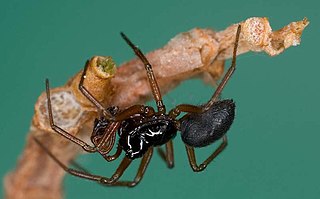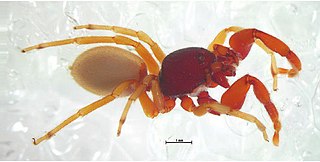
Erigoninae are the largest subfamily of sheet weavers (Linyphiidae), which is itself the second largest spider family. In the United States they are known as dwarf spiders, while they are called money spiders in England. The exact taxonomic limits of the subfamily are not yet known.

Pirate spiders, members of the family Mimetidae, are araneomorph spiders which typically feed on other spiders.

Cybaeidae is a family of spiders first described by Nathan Banks in 1892. The diving bell spider or water spider Argyroneta aquatica was previously included in this family, but is now in the family Dictynidae.

Pimoidae is a small family of araneomorph spiders first described by J. Wunderlich in 1986. It contains 37 species in four genera and is monophyletic. It is closely related to the Linyphiidae, and is sometimes treated as synonymous with that family.

Austrochilidae is a small spider family with ten species in three genera. Austrochilus and Thaida are endemic to the Andean forest of central and southern Chile and adjacent Argentina, while Hickmania is endemic to Tasmania. The monophyly of the family and the relationships among the genera are uncertain as of May 2017.

The Palpimanoidea or palpimanoids, also known as assassin spiders, are a group of araneomorph spiders, originally treated as a superfamily. As with many such groups, its circumscription has varied. As of September 2018, the following five families were included:

Araneoidea is a taxon of araneomorph spiders, termed "araneoids", treated as a superfamily. As with many such groups, its circumscription has varied; in particular some families at one time moved to the Palpimanoidea have more recently been restored to Araneoidea. A 2014 treatment includes 18 families, with the araneoids making up about 26% of the total number of known spider species; a 2016 treatment includes essentially the same taxa, but now divided into 17 families.
The Haplogynae or haplogynes are one of the two main groups into which araneomorph spiders have traditionally been divided, the other being the Entelegynae. Morphological phylogenetic studies suggested that the Haplogynae formed a clade; more recent molecular phylogenetic studies refute this, although many of the ecribellate haplogynes do appear to form a clade, Synspermiata.

The Entelegynae or entelegynes are a subgroup of araneomorph spiders, the largest of the two main groups into which the araneomorphs were traditionally divided. Females have a genital plate (epigynum) and a "flow through" fertilization system; males have complex palpal bulbs. Molecular phylogenetic studies have supported the monophyly of Entelegynae.

Phonognatha is a genus of South Pacific orb-weaver spiders first described by Eugène Simon in 1895. It was originally placed with the long-jawed orb weavers, and was moved to Araneidae in 2008.

Orbiculariae is a potential clade of araneomorph spiders, uniting two groups that make orb webs. Phylogenetic analyses based on morphological characters have generally recovered this clade; analyses based on DNA have regularly concluded that the group is not monophyletic. The issue relates to the origin of orb webs: whether they evolved early in the evolutionary history of entelegyne spiders, with many groups subsequently losing the ability to make orb webs, or whether they evolved later, with fewer groups having lost this ability. As of September 2018, the weight of the evidence strongly favours the non-monophyly of "Orbiculariae" and hence the early evolution of orb webs, followed by multiple changes and losses.
Gelanor waorani is a species of neotropical spiders from South America in the family Mimetidae.
Gelanor siquirres is a species of neotropical spiders from Costa Rica in the family Mimetidae.
Gelanor moyobamba is a species of neotropical spiders from Peru in the family Mimetidae.
Gelanor juruti is a species of neotropical spiders from South America in the family Mimetidae.
Gelanor is a genus of spiders in the family Mimetidae, found in Central and South America.

Ochyrocera is a genus of midget ground weavers that was first described by Eugène Louis Simon in 1892.
Putaoa is a genus of East Asian araneomorph spiders in the family Pimoidae, and was first described by G. Hormiga & L. Tu in 2008. As of June 2019 it contains only three species, found only in Taiwan and China: P. huaping, P. megacantha, and P. seediq.
Anansi is a genus of African pirate spiders first described by L. R. Benavides, G. Giribet & Gustavo Hormiga in 2017. It is named after Anansi, a trickster god of Akan folklore. As of April 2019 it contains only three species.










